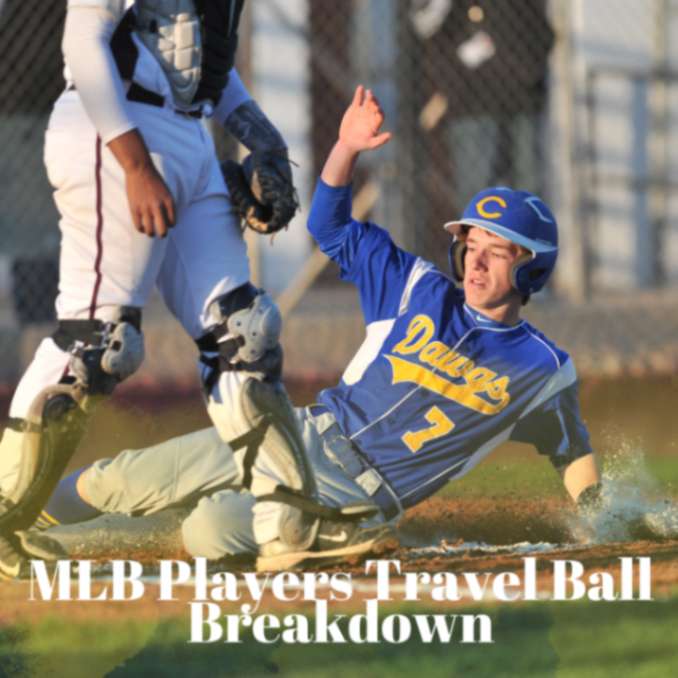
Introduction
From Little League Dreams to MLB Stardom: The Journey Through
Travel Ball
When you used to swing a bat at your neighborhood park, did you ever see the fans going wild in the stands as you hit a home run in an MLB stadium? That’s not simply a dream for a lot of young people; it’s something they actively strive for. What then is the magic ingredient that makes these fantasies come true? Yes, that’s right travel ball.
What is Travel Ball and Why is it the Gateway to MLB?
Travel ball or travel youth baseball is a whole different ball game—literally—than your average neighbourhood baseball. Consider it the Ivy League for aspiring baseball players. Travel ball competitions, which are primarily held during summer breaks, provide intense competition and draw elite players from different areas. Talent thrives there, so it should come as no surprise that a sizable portion of MLB players began their careers in these leagues. To put it simply, travel ball is an essential first step for anyone hoping to play in Major League Baseball.
The MLB Players Travel Ball Breakdown
Now, let’s get right to the point. There is a lot of talk and some urban legends about travel ball and its contribution to the development of MLB players. Now let’s get our hands dirty and take a closer look. The facts, nothing but the facts. We’ll dispel a few myths and provide you with the truth “mlb players travel ball breakdown”.
You’ll comprehend the specifics of the MLB players travel ball breakdown and why it’s revolutionary for players who aspire to play in the major leagues, how many mlb players played travel ball and what percentage of college baseball players played travel ball by the finish of this essay.
An Intro to Elite Youth Baseball
When it comes to youth baseball, travel ball is in a league of its own literally “mlb players travel ball breakdown”. Also known as “select” or “elite” baseball, this high-level sport has teams that are hand-picked to duke it out with top talents from different cities, states, or even countries.
Far from the casual air of your local Little League, these teams demand tryouts and ooze competitiveness. Originating in the late 20th century, travel ball has quickly become a nursery for future MLB stars. Within this MLB players travel ball breakdown, we’ll explore how this form of baseball is more than just a game—it’s a career launchpad.
Regular League vs. Travel Ball
Let’s face it: not every baseball league is made equal. Everyone has the opportunity to play and learn in their neighborhood league. It’s all about having fun, forming a community, and experiencing the game. Ball in travel? That is a different tale. Here, “competitive” is the operative term “. Travel ball players are expected to dedicate much more time and effort, and coaches offer specialized training. Consider travel ball as the college level, when the game becomes more genuine and the stakes are higher, and Little League as the high school stage.
Why Travel Ball Matters in the Journey to the MLB
You might be wondering, “Why all this fuss about travel ball?” Well, it’s simple: if you’re a young baseball talent dreaming of the MLB, travel ball is your golden ticket. Offering a space for exceptional skills to shine, get nurtured by top coaches, and face fierce competition, travel ball is a pivotal rung in the ladder to professional baseball.
It’s the real-world stage where young players can impress MLB scouts and, who knows, even score a college scholarship. Within this MLB players travel ball breakdown, we’ll delve into why this intense form of youth sports can make or break your chances of getting that coveted MLB contract.
A Player’s Typical Path
You play travel ball, so you’re a big fish in a little pond, but what will come next? This portion of our MLB players travel ball breakdown is essential reading if the MLB is your goal. When you play travel ball, you usually get scouts’ attention quite early on “mlb players travel ball breakdown”.
Players benefit from the first experience when they advance to more competitive levels and frequently to the international arena. But the adventure doesn’t finish there. The next major turning points in baseball are high school and college. MLB scouts are hunters here, searching for the next big thing, not just spectators. If you make an impression on them, you can wind up in the minor leagues, the draft, or, if your luck holds true, the bright lights of the Major Leagues.

MLB Players Who Cut Their Teeth in Travel Ball
How many players have played in the mlb players travel ball breakdown ?Hey, Mike Trout? Though he is well-known in MLB circles, did you know that the guy began playing travel ball? Furthermore, he is not alone. Let’s examine some actual cases to further explore our analysis of MLB players’ travel balls.
Trout attracted notice left and right as a travel ball standout at an early age. His early involvement in those high-stakes contests equipped him with the abilities and exposure needed to be selected by the Los Angeles Angels in the draft. And yet the tales do not conclude with Trout. A plethora of players, including Clayton Kershaw and Bryce Harper, utilized travel ball as a springboard to become major league players.
Incorporating real-world examples and concentrating on the travel ball to MLB trip, our goal is to provide insight into this important part of a player’s professional path mlb players travel ball breakdown. Knowing this path can give parents and young players alike important insights into what it takes to go from local talent to national sensation. This breakdown of MLB players’ travel balls is meant to serve as your roadmap for this thrilling adventure.
Busting Common Myths
The Only Road to mlb players travel ball breakdown
You might believe that travel ball is the golden path leading straight to the MLB, but hold your horses! While travel ball can give a major boost, it’s not the end-all-be-all. There are players who’ve hit home runs in their careers by going through college baseball or even soaring through international leagues. So, it’s not the only game in town if you’re aiming for the MLB spotlight.
Travel Ball Drains the Family Bank Account
Many folks think travel ball is a wallet-buster, but don’t jump the gun. A good number of organizations are in your corner, offering scholarships or sliding scale fees to lighten the financial load. And hey, think of it as an investment. The money you put in can come back to you in spades through college scholarships or, if the stars align, even a shot at going pro.
A Guaranteed Future? Not So Fast!
Don’t believe that signing up for travel ball is your ticket to an MLB draft slot or a college scholarship. Travel ball is not a magic wand, but it can give you an advantage ‘mlb players travel ball breakdown’. Granted, you acquire invaluable experience that sets you apart from the competition, but nothing is certain. Equally significant are skill, commitment, and occasionally simply being in the right place at the right time. Travel ball can therefore help you perform better, but keep in mind that it’s not a certain formula for success.
The Pros and Cons Unveiled
Gaining the Limelight and Skill Boost
When discussing the advantages in our mlb players travel ball breakdown, the first thing that comes to mind is exposure. Playing in travel ball leagues is like holding a giant sign that says, “Scouts, come look at me!” The eyeballs you get from colleges and pro leagues are unmatched.
Another perk is the stiff competition. You’re not just playing catch in the backyard anymore; this is the real deal. Competing against top talent forces you to elevate your game to new heights mlb players travel ball breakdown. And let’s not forget skill development. Compared to local leagues, travel ball often offers superior coaching and practice regimens mlb players travel ball breakdown.
Counting the Cost and Weighing the Risks
Let’s now discuss turkey while flipping the coin regarding the disadvantages in our evaluation of MLB players’ travel balls. First, the price. Travel balls may burn a hole in your pocket, let’s face it. Families may find themselves financially strained as a result of the payments. There’s also the time commitment.
We’re talking about days on the weekends, days off from work, and possibly even some school days devoted to the sport. Not only is the player dedicated, but the family frequently needs to change schedules. The pressure cooker comes last. The stakes are incredibly high, and not all players can handle that level of pressure. When balancing the demands of their sport with their academic and social lives, some young athletes experience burnout.
Conclusion
We’ve gone over the specifics of trip ball, dispelled a few urban legends, and listed the advantages and disadvantages. Travel ball isn’t the only route or a guarantee of success in the future, but it can play a big role in a player’s path to the mlb players travel ball breakdown.
Making educated judgments about travel ball can benefit players and families by knowing the truth about it. Understanding the basics will help you get around this thrilling, difficult world of professional baseball, whether your goal is to play for the Major League Baseball or just to enjoy the game. That environment.
FAQs
- What is the average cost of participating in travel ball? The cost can vary widely depending on the level of the team and the location, but families can expect to spend several thousand dollars per season on league fees, travel, equipment, and more.
- How do scouts use travel ball to evaluate talent? Scouts often attend travel ball tournaments specifically to evaluate young talent. They look at not just skill level, but also how a player behaves on and off the field: teamwork, attitude, and potential for growth.
- Can playing in a travel ball league hurt a young player’s chances for success? While travel ball can offer many advantages, it’s not without risks. The high level of competition and pressure can be overwhelming for some players, and not everyone thrives in
- What is the level of time commitment for travel ball versus other leagues? Travel ball usually requires a significant time commitment, including weekends and potentially long-distance travel, whereas local leagues are generally less demanding of your time.


